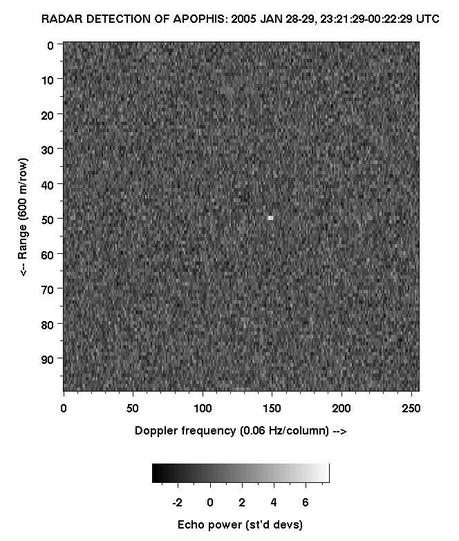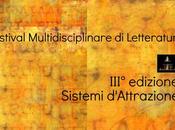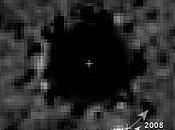- Pubblicato Venerdì, 31 Ottobre 2014 06:44
- Scritto da Elisabetta Bonora

Arecibo, 28-29 gennaio 2005, 0.192 AU - Credit: L. Benner (JPL) NASA
A gennaio 2013, contro ogni scenario catastrofico dilagante, era arrivata la conferma da parte della NASA: "l'asteroide Apophis non colpirà la Terra". Ad ogni modo, c'è ancora tempo per potersi preoccupare perché Apophis non si avvicinerà alla Terra prima di venerdì 13 aprile 2029 (brutta data per i superstiziosi!), quando effettuerà il primo di due flyby intorno al nostro pianeta, arrivando entro i 35.000 chilometri (il secondo sarà nel 2036).
Il primo sorvolo, in ogni caso, altererà l'orbita dell'asteroide rendendo un po' incerte le previsioni successive ma, entrare nel campo d'azione della gravità terrestre, potrebbe generare anche altri effetti minori sulla roccia spaziale. E questo è ciò che una squadra di scienziati statunitensi, cinesi e francesi si è preoccupato di scoprire.
Il team, non disponendo di materiale fotografico specifico, ha utilizzato le immagini dell'asteroide Itokawa, prese dalla sonda Hayabusa (Hayabusa 2 verrà lanciata il prossimo 30 novembre), che per dimensioni (circa 320 metri di diametro) è piuttosto simile ad Apophis e, forse, lo è anche nella composizione.
Itokawa, ad esempio, si è dimostrato un corpo composto da una massa di rocce di varie dimensioni, tenute insieme dalla loro stessa forza di attrazione gravitazionale. Se Apophis non fosse un oggetto unico ed utilizzasse lo stesso "trucco" di Itokawa, allora è probabile che alcune rocce vengano mosse sulla sua superficie a causa dell'attrazione gravitazionale terrestre. Per verificare queste ipotesi, il team ha lavorato su simulazioni computerizzate, tenendo conto anche dell'attrazione gravitazionale di Apophis, della forza centrifuga dovuta alla rotazione dell'asteroide, delle forze inerziali e di altri fattori che potrebbero entrare in gioco.
I modelli hanno mostrato che sulla superficie di Apophis potrebbero generarsi dolci frane e piccoli rotolamenti, creando situazioni ancora più intriganti da studiare. Gli scienziati, infatti, analizzano la luce riflessa dagli asteroidi per calcolarne l'età e, se lo strato più superficiale verrà rimosso, si potrà conoscere meglio la sua storia.
Numerical predictions of surface effects during the 2029 close approach of Asteroid 99942 Apophis [abstract]
Asteroid (99942) Apophis’ close approach in 2029 will be one of the most significant small-body encounter events in the near future and offers a good opportunity for in situ exploration to determine the asteroid’s surface properties and measure any tidal effects that might alter its regolith configuration. Resurfacing mechanics has become a new focus for asteroid researchers due to its important implications for interpreting surface observations, including space weathering effects. This paper provides a prediction for the tidal effects during the 2029 encounter, with an emphasis on whether surface refreshing due to regolith movement will occur. The potential shape modification of the object due to the tidal encounter is first confirmed to be negligibly small with systematic simulations, thus only the external perturbations are taken into account for this work (despite this, seismic shaking induced by shifting blocks might still play a weak role and we will look into this mechanism in future work). A two-stage approach is developed to model the responses of asteroid surface particles (the regolith) based on the soft-sphere implementation of the parallel N-body gravity tree code pkdgrav. A full-body model of Apophis is sent past the Earth on the predicted trajectory to generate the data of all forces acting at a target point on the surface. A sandpile constructed in the local frame is then used to approximate the regolith materials; all the forces the sandpile feels during the encounter are imposed as external perturbations to mimic the regolith’s behavior in the full scenario. The local mechanical environment on the asteroid surface is represented in detail, leading to an estimation of the change in global surface environment due to the encounter. Typical patterns of perturbation are presented that depend on the asteroid orientation and sense of rotation at perigee. We find that catastrophic avalanches of regolith materials may not occur during the 2029 encounter due to the small level of tidal perturbation, although slight landslides might still be triggered in positions where a sandpile’s structure is weak. Simulations are performed at different locations on Apophis’ surface and with different body- and spin-axis orientations; the results show that the small-scale avalanches are widely distributed and manifest independently of the asteroid orientation and the sandpile location. We also include simulation results of much closer encounters of the Apophis with Earth than what is predicted to occur in 2029, showing that much more drastic resurfacing takes place in these cases.





